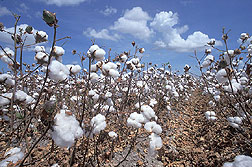This page has been archived and is being provided for reference purposes only. The page is no longer being updated, and therefore, links on the page may be invalid.
|
Read the magazine story to find out more. |
|
|
|
|
ARS Nursery in Mexico Plays Key Role in Cotton Breeding
By Dennis O'BrienJanuary 7, 2010
There may not be a birthday cake, but this year’s 60th anniversary of the Agricultural Research Service (ARS) Cotton Winter Nursery (CWN) in Tecoman, Mexico, is a milestone worth celebrating.
The CWN is the site for about two dozen government, university and private scientific research projects each year and an essential tool for ARS scientists working to enhance the nation’s $3.8 billion cotton crop.
The nursery’s years of service make it one of the longest running cooperative facilities of its kind. Later this year, Mexican and U.S. scientists plan to discuss the CWN’s future operations at an annual conference in nearby Manzanillo, Mexico.
Since its inception, the CWN has been operated jointly by ARS, the National Cotton Council of America, and the Mexican Institute of Forestry, Agriculture and Livestock Research, Mexico’s ARS equivalent. A committee of government, academic and industry scientists serves as advisors.
Cotton seeds stay viable for only about 10 years, so each year the curator of the ARS Cotton Germplasm Collection in College Station, Texas, sends between 700 and 1,000 cotton accessions to the CWN to produce new seeds. Each plant represents a storehouse of unique genetic material that could prove useful for increasing yields, improving fiber quality and controlling future pests and pathogens.
Cotton is particularly susceptible to insects, pathogens and environmental extremes and together they can make it a challenge to produce plants with the right combination of long, strong fibers that are uniform in length.
There also has been stagnation in cotton yields in recent years. Many experts attribute that stagnation to the crop's narrow genetic base, but less than 1 percent of the plant’s genetic base has been explored. The nursery’s tropical location provides a setting for that exploration by ensuring a habitat for many wild collected varieties and shortening the time required to study and develop new varieties by allowing researchers to raise two generations of cotton each year.
Read more about this and other ARS collections in the January 2010 issue of Agricultural Research magazine.
ARS is the principal intramural scientific research agency of the U.S. Department of Agriculture.

